Relate INAH archaeologists discovering the tomb of a high chief maya
Burial chamber mural found almost intact with the dawn of Palenque
Located in the twentieth temple was opened on Tuesday, after 13 years of hard work of the team led by Arnoldo Gonzalez Cruz
"This could be the first ajaw Palenque royal house, "said
It is now urgent to safeguard the painting walls and ceiling covering
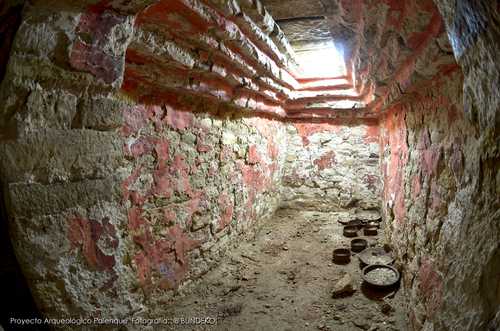
View of the entrance to the chamber, the oldest discovered in the area. The walls are seen the remains of the vessel wall and floor Blindekol Photo / INAH
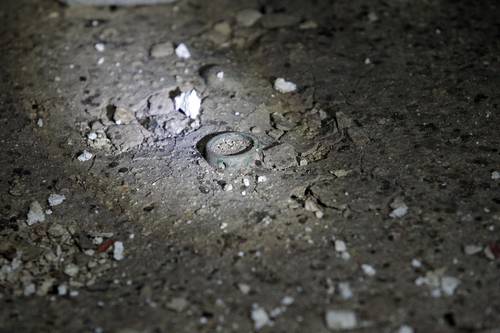
When removing the last slab covering the burial Room vain, and after several minutes of contemplation, archaeologists identified on the floor a ring, a pendant and about 50 or 60 jade beads and 11 vessels Ceramic Photo Ortega Cortes Yazmín
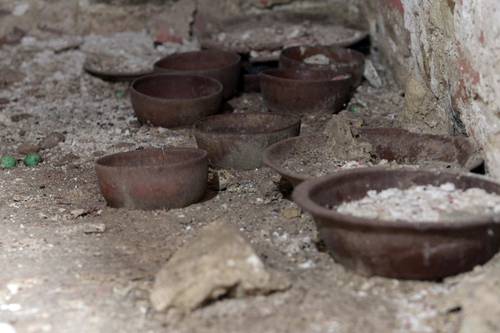
When removing the last slab covering the burial Room vain, and after several minutes of contemplation, archaeologists identified on the floor a ring, a pendant and about 50 or 60 jade beads and 11 vessels Ceramic Photo Ortega Cortes Yazmín
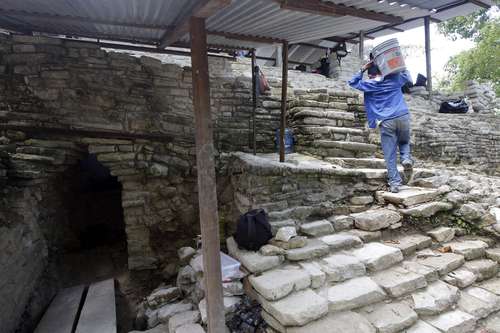
The burial chamber is a rectangular space of about 3.40 m long, 1.43 wide and about 2.50 height. Is at a depth of seven meters from the top of the temple, which has a total height of 18 meters Ortega Cortes Yazmin Photo
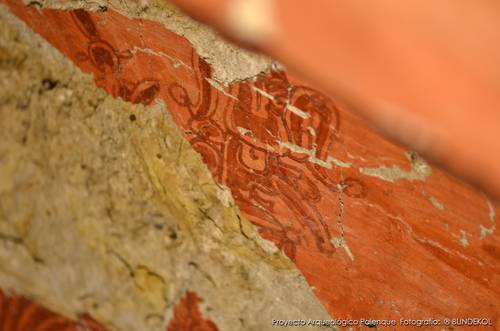
Detail of the mural, which prevails in the red color of the Maya funeral Blindekol Photo / INAH
Monica Mateos-Vega
Submitted
La Jornada
Monday September 10, 2012, p. a10
Monday September 10, 2012, p. a10
Palenque, Chiapas., September 9.archaeologists and researchers from the National Institute of Anthropology and History (INAH) found in the archaeological site of Palenque, Chiapas, a Mayan burial chamber mural, the first to be discovered almost intact, associated very probably the tomb of an important character.
It is the oldest, from about the year 450 of our era, the dawn of this majestic metropolis of ancient Mexico, now considered world heritage site by the United Nations Educational, Scientific and Cultural Organization.
The new discovery will change the course of studies on the history and religion of the ancient Maya, say the experts, who hypothesize be on the trail of a great tomb of royalty who ruled the region for over 500 thousand years.
The line of research that is gaining strength is that maybe it's buried in one of the ajaw (kings) who started the dynasty that is part of K'inich Janaab 'Pakal (603-683 AD), also known as Pakal II or Pakal the Great, whose elaborate and rich tomb is today one of the most important archaeological treasures of Mesoamerica.
The burial chamber is located in the temple XX and was open on Tuesday, after 13 years of painstaking research and excavations by a team led by archaeologist Arnoldo Gonzalez Cruz, the same that brought to light the tomb of called Red Queen, in 1994, also in Palenque.
The newfound vaulted room was located in 1999 during the explorations conducted by archaeologists Merle Greene Robertson (died April 22, 2011) and Alfonso Morales Cleveland, as part of the work of the Institute of Pre-Columbian Art Research (non profit organization, founded by Green, who has funded major research on art, iconography and epigraphy Mesoamerican).
Through a hole of 10 centimeters, Mayanists experts were then able to take a picture of one of the figures in the mural, but due to the instability of the site and the intricacy of its location, among other reasons, for nearly a decade of research stopped and there was no clear idea of what was inside.
Finally, on Tuesday, September 4, 2012, at noon, in the midst of a hopeful atmosphere of concentration, enthusiasm and a wealth of emotions about professionalism and scientific performance, the team Arnoldo González Cruz, supported by archaeologist Rogelio Rivero Chong , could remove the last of the slabs that covered the span of the burial chamber.
Several minutes stopped to contemplate the splendor of its interior: walls and ceiling in various shades of red (the color of the Maya funeral), and reflected on the walls richly dressed human figures, on the floor, scattered, a ring, a pendant and about 50 or 60 round jade beads, large, and 11 ceramic vessels.
The figures in the paintings are very similar to the characters that appear in stucco relief on the walls of the chamber of Pakal in the Temple of the Inscriptions.They would be the lords of the underworld, called Bolon Tiku, which are mentioned in the sacred book of the Quiche Maya, the Chilam Balam of Chumayel. They stand with feather headdresses, and round shields with scepters foot snake. The best preserved are the four figures that are located on the wall on the west side and four on the east side, in the north wall there is only a small portion of the mural.
During the laborious process of opening, which on several occasions had to be suspended because of the risk of a crash, a detail almost imperceptible to the untrained eye noticed the archaeologists: fabric remnants around the entrance, as if been lined with a fine cheesecloth before being sealed, a sort of wrap-cocoon to protect the eternal dream of the important character probably lies there. This is a really never appreciated in a Mayan tomb.
The burial chamber is a rectangular space of about 3.40 meters long, 1.43 wide and approximately 2.50 high. Is at a depth of seven meters from the top of the temple, which has a total height of 18 meters. That is, it is located near the center of the structure, which was very difficult to build the well to reach it.
Is lowered by two vertical ladders attached to the walls, a metal and a wood. Below, the heat and humidity cause fogging the windows of those who use glasses. A fan is on when the temperature gauges rise, therefore, on the threshold of the camera can not stay more than three people for a long time.
Archaeologists, architects, photographers, surveyors, restorers, designers and assistants who take buckets of sand and bits of rock, are privileged to shift up and down to the grave, but none with the big smile of Eugenio Alvaro Jimenez, a deaf worker , the first to enter the tomb of the Red Queen in 1994 and now the first to help remove the slabs that covered the entrance to this room.
Such is the experience and the infectious enthusiasm of Eugene, who with great speed and skill, without a trace of fatigue, sieve the material exiting the chamber inlet: tiny pieces of wall, stucco flattened, small green beads, remains than they look up animal bones and dried insect pupae.
Within the chamber
It is in the small space in front of the newly opened temple burial chamber in which twentieth-do not touch the walls with bare hands to avoid contaminating potential carbon materials, where archaeologists get to La Jornada to speak from the grave
which cost us a lot of effort. The painting is amazing, it's a shame that was not completely preserved, but still provides a lot of information, Arnoldo Gonzalez Cruz explains.
So far, no one has entered fully into the room. Perhaps one or two steps, albeit with socks and carefully, to place the devices that measure temperature and humidity.
The urgent now, he adds, is to build a platform with metal pipes and planks to enter without damaging the material found on the floor and proceed to bailout the mural, which has evolved in various points.
Once established and set painting walls and vault, will proceed to analyze, record, and remove the pieces of jade and pottery.
What's down there? A stairway? A sarcophagus? A crypt? 'Another camera?A skeleton?
Arnoldo Gonzalez Cruz is prudent to answer:
do not know yet. Until we begin to remove the floor know if there is another level, or if we find bones. The first is the storage of the paint. In other temples, as in the XVIII-A, we find remains of mural, but very small, only three bits in the vault. Here are a lot of good (stored). It is probably made with red hematite, different gradations were achieved by adding more or less lime.
- Is this a tomb of a Mayan dignitary?
'Very likely. The camera has attributes that can be identified as a royal burial, although it has not been possible to identify skeletal remains for now. If we rely on the epigraphy known and if the dates of the vessels are what we think, here could be the first ruler in actual historical time of Palenque is known: K'uk B'alam (meaning Quetzal Jaguar), the first ajaw Palenque royal house, but until you dig and explore can not say anything, because we have nothing, it would be very risky to say who it is.Some believe that this tomb, to resemble that of Pakal, maybe is the grandmother (Mrs. Olnal, who ruled Palenque for 20 years, from 583 until his death in 604 AD), or the mother, but are speculations . Until we have not worked this well know.
"We have not touched anything, because there is the risk of collapsing the paint. It is so delicate that we have a very precise control. Our main problem is the instability of the fill, so we took some time to consolidate the structure to get here, otherwise we all fell apart.
"But we are facing the only example of a burial chamber with murals that retains almost all of its features, hence it will be possible to make comparisons with other Palenque Mayan tombs, like the Red Queen, the Temple of the Skull or the grave XVIII Temple III-A, and also with other major cities of Maya and Calakmul, Copán, Tikal and Piedras Negras, which will allow us to make some inferences about ancient burial rituals and beliefs of the Maya. "
A total of about 60 people working exclusively on exploring the Temple XX tomb, in days that start at seven in the morning and conclude at 11 pm,
because many are chopped with the work, we do not liability.
We are not hunters graves
They make only two breaks, to go to breakfast and lunch at the camp built in the 50s by archaeologist Alberto Ruz Lhuillier (1906-1979), discoverer of the tomb of Pakal. In a short break, some young restaurateurs in television watching National Geographic Channel documentary showing the neat paraphernalia Egyptologist Zahi Hawass findings, no sweat, in excavations in September hollywodense.
What false!, say and retire to continue working shoulder to shoulder, covered with dust, helping to transport tubes or removing slabs, amid the moist heat of a lush jungle is still covered 70 percent of the former B ' aakal, now called Palenque.
If it had that passion, Rogelio Rivero points out,
no one would endure being away from his family for several months (this season began work in May and should be completed in December), the grave has become hard to get, but is giving much new information about Palenque, to understand not only the site, but the entire Mayan world ... And what we lack.
Work in the Twentieth temple, located in the southern area of the archaeological site, is meticulous and slow, despite the anxiety that betray those who come to ask:
Have you dug up the dead?Area are closed to the public. The structure, facing east, is now covered with sheets to allow excavations continue even under the summer rains.The pottery found so far, gives a date of construction of the temple the years 500 to 600 AD.
We are not hunters tombs, emphasizes the archaeologist Arnoldo Gonzalez Cruz, "we have that school. We are interested in the comprehensive rescue Palenque, ie we also care about your architecture (Pakal was thrilled by it), which is why, here in the Temple XX, not only work in the exploration of the burial chamber, makes us be consolidated throughout.
That is what we must think of new generations dedicated to investigate the area: it is a city which is only open to the public and explored 20 or 30 percent.For example, we know the start, we still get out a bit of the core area of the city, do not know where pottery was produced, where the sculpture was carved (very abundant in the area), how everyday life was lived outside where rulers. In this sense, the future might be found in tombs, buildings and most beautiful pieces, rich and interesting that we have located so far. There Archaeology for awhile. Pakal's tomb is the most spectacular we've found, and it is quite possible that here in the Temple XX tomb, have similar characteristics.
- To view and in the coming days?
-In the coming weeks, perhaps until December. Much remains to be investigated, concluded the archaeologist, happy, but reserving the euphoria for what still needs to be found.
- ApologyMonica Mateos-VegaAn apology to the archaeologist Arnoldo Gonzalez Cruz by changing its name.
- Was there cocoa in the offering?Monica TelloHello, do you think that some of the vessels have an offering of cocoa?
- regardsVictor IbarraCacao offerings had possibly because it was a regular part of the royalty, the Cacao was intended to royalty and their offerings to the deceased dignitaries, but there is a drawback that a perishable product over the years erasing his evidence is destroyed.
- Lacks the essentialGuillermo MarinGood for Mexican archeology!, But we lacked the essentials. Not just "discover" the vestiges of the old grandparents and take them to a museum for tourists. Missing the essentials: to investigate, promote and impart ideas and deep spiritual meanings that inspired its creation, for those values and principles, building the future of the nation.www.toltecayotl.org
- 0seaThat toltecayotl.org who goes by the internet? If you promote our civilization, within this black box only thing it does is to benefit our Country intruders who come to kill us and steal our Earth. "The less they know, the more you will have value" or vulgarized and e hereby EVERYTHING! Watch out!
- CommentRicardo JimenezThe wonder of beauty and passion allazgo archaeologists to unravel the secrets, and the conservation and restoration of other cultural manifestations of nuestos ancestors is highly rewarding.
- ClarificationAdrianA very touching story indeed, but I would like to clarify that only the Chilam Balam of Chumayel is the sacred book of the Quiche. The Chilam Balam of Chumayel Yucatan is home. It is very likely that the author of the article intended to rely to Popol Vuh, a quiche eminently source text. Greetings.
- important clarificationRomanArchaeologists are researchers, so to clarify "Archaeologists and researchers ..."


















